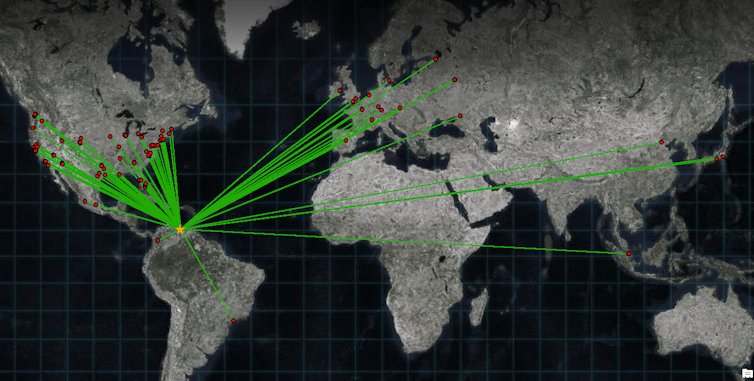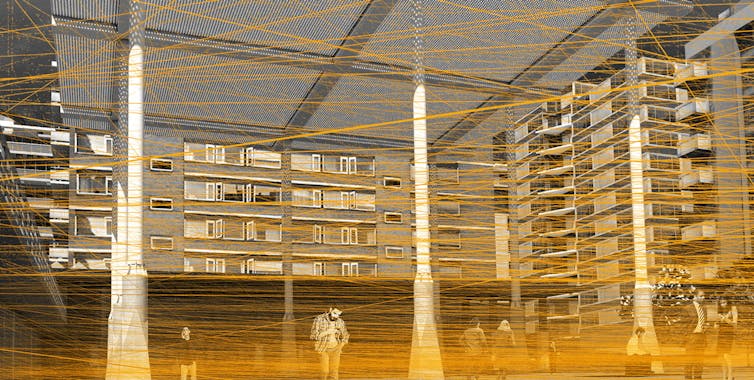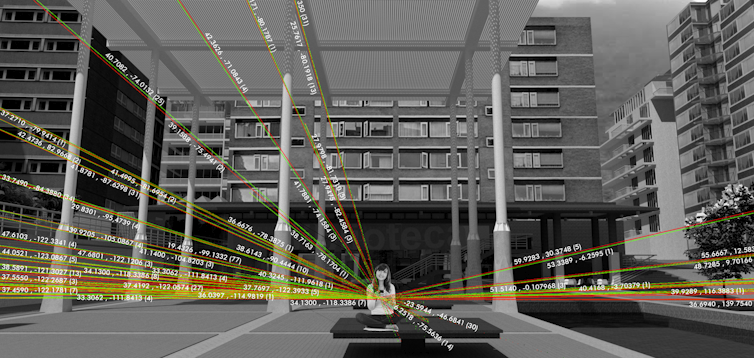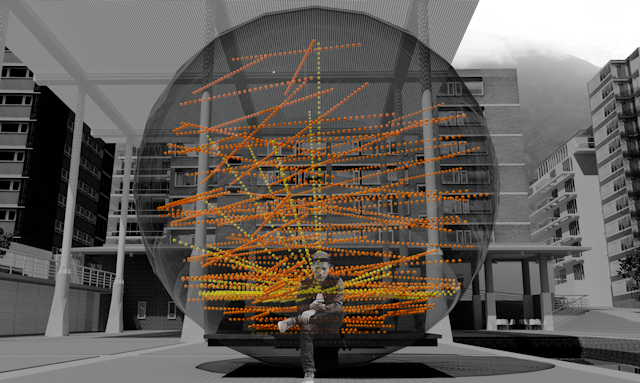In the digital world, any action we do generates data – whether browsing the internet, answering emails or messaging our friends. Translated into radio waves, this information can travel almost effortlessly through space in a split second. Data are all around us, invisibly occupying the space between ourselves and other objects in the built environment. My colleagues and I conducted a study to understand how the presence of all this data alters our understanding of personal and public spaces.
As a case study, we set up an open Wireless Local Area Network (WLAN) in Plaza de Los Palos Grandes in Caracas, for people to connect free of charge for a limited period of time. A total of 123 people connected to our WLAN with their devices, sending and receiving packets of information to and from servers across the world.

From the packets, we extracted the location of the servers to which each user connected. In the image below, we generated one line for each connection established between the person and the servers. It demonstrates how the data generated by an email to a close friend, composed in the intimate space between you and your device, has the potential to reach across the world.
Here’s how it works: the smart phone converts your email into radio waves and sends the information to a WiFi router. It’s then passed to your email provider’s servers, then – through the internet’s Transmission Control Protocol (TCP), which controls the movement of data across the web – to the other provider’s servers and to your friend’s inbox.
Changing space
People tend to think that personal communication originates within the intimate dimension of our personal space. We consider the space immediately around us to be ours and personal – it’s where we think, formulate ideas and speak with others. This study gave us the opportunity to consider how the shape of our personal space is changing as we live our digital lives in public spaces.

The term “personal space” has meant different things since architects, urbanists, sociologist and geographers started studying it. In the 1960s, personal space was thought of as the distances we maintain from others, to control our interactions with them. The size of this invisible aura could vary, depending on cultural values, the density of people around you and other circumstances.
Scholars have tried to argue that in the digital era, our “personal bubble” is not just physical – it’s also virtual. They claim that your personal bubble is a membrane which filters the data you that send out and the information you receive back. It’s the sum of all the settings and agreements across different digital platforms – including apps, social media and email – as well as the phone itself, which help you to manage your personal, group and public data and communications.

But our results show that in the digital realm, personal space isn’t like a bubble which surrounds each person, helping to define the nature of their encounters, relationships, intimacies or invasions. In fact, it’s more like a global network of connections, reaching everywhere, coming from each person whenever they send or receive a packet of data.
Our images show how personal space disperses through the atmosphere and materialises in someone else’s device in a matter of seconds, leaving traces in a dispersed constellation of servers. Because of this, personal space has become dynamic – it changes in real time with our digital interactions.
Given how sensitive we are to invasions of our physical personal space, it’s remarkable that many of us don’t even realise the extent of our digital personal space, which is scattered around servers and other devices around the world. By visualising the massive size and dispersed form of our digital personal space, people will become more protective of their data, taking a greater interest in the level of encryption, privacy and permissions granted to each app they use.
Personal space is no longer the immediate space that surrounds us and that moves with us. It is rather something more abstract – globally distributed and possibly everywhere at any time. The next time we look at our phone to send a text message, we should envision the real extent of our space, that goes to the other side of the globe in seconds to pin back to us. Our personal space is not a bubble anymore – it is a global network.

